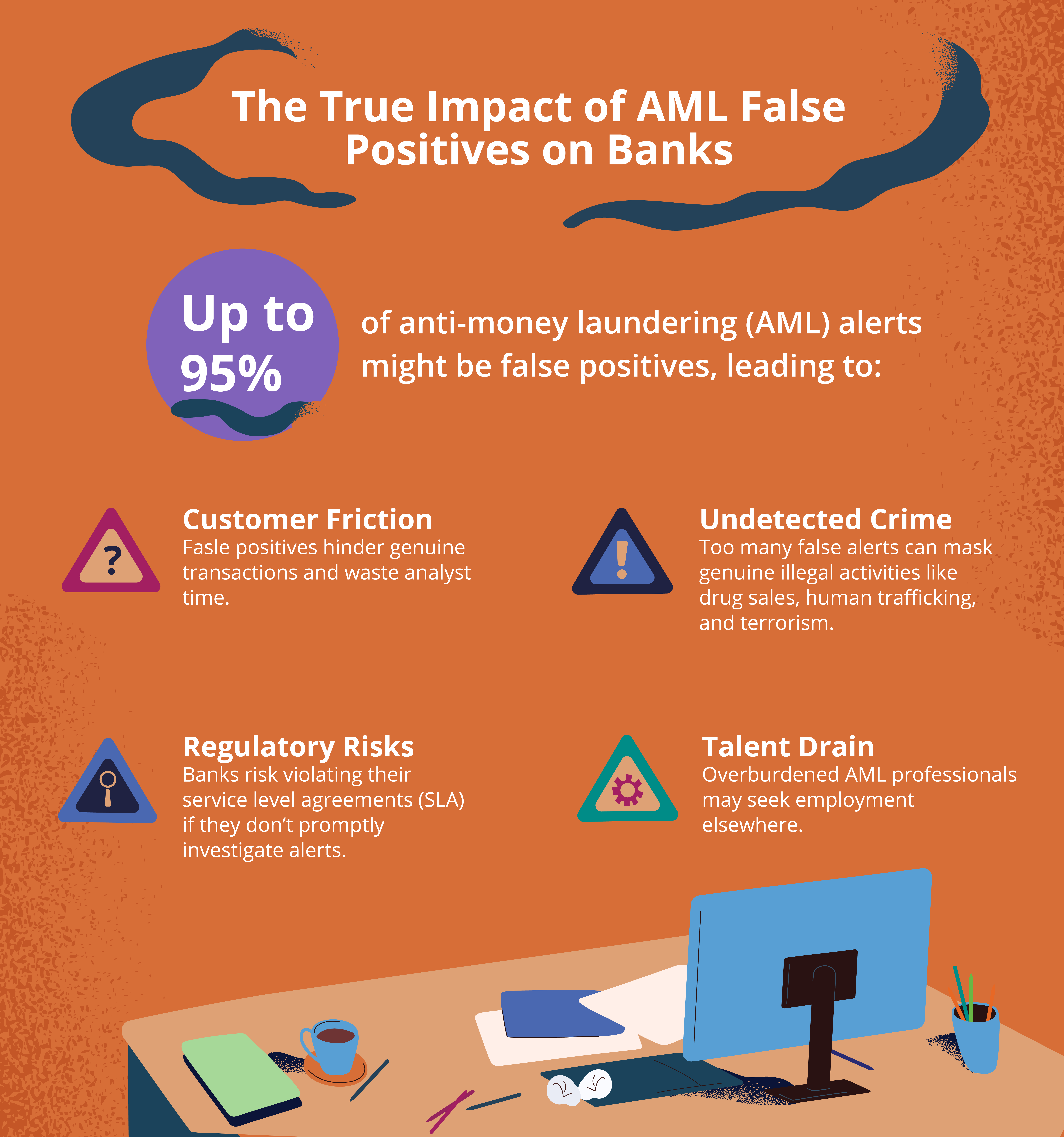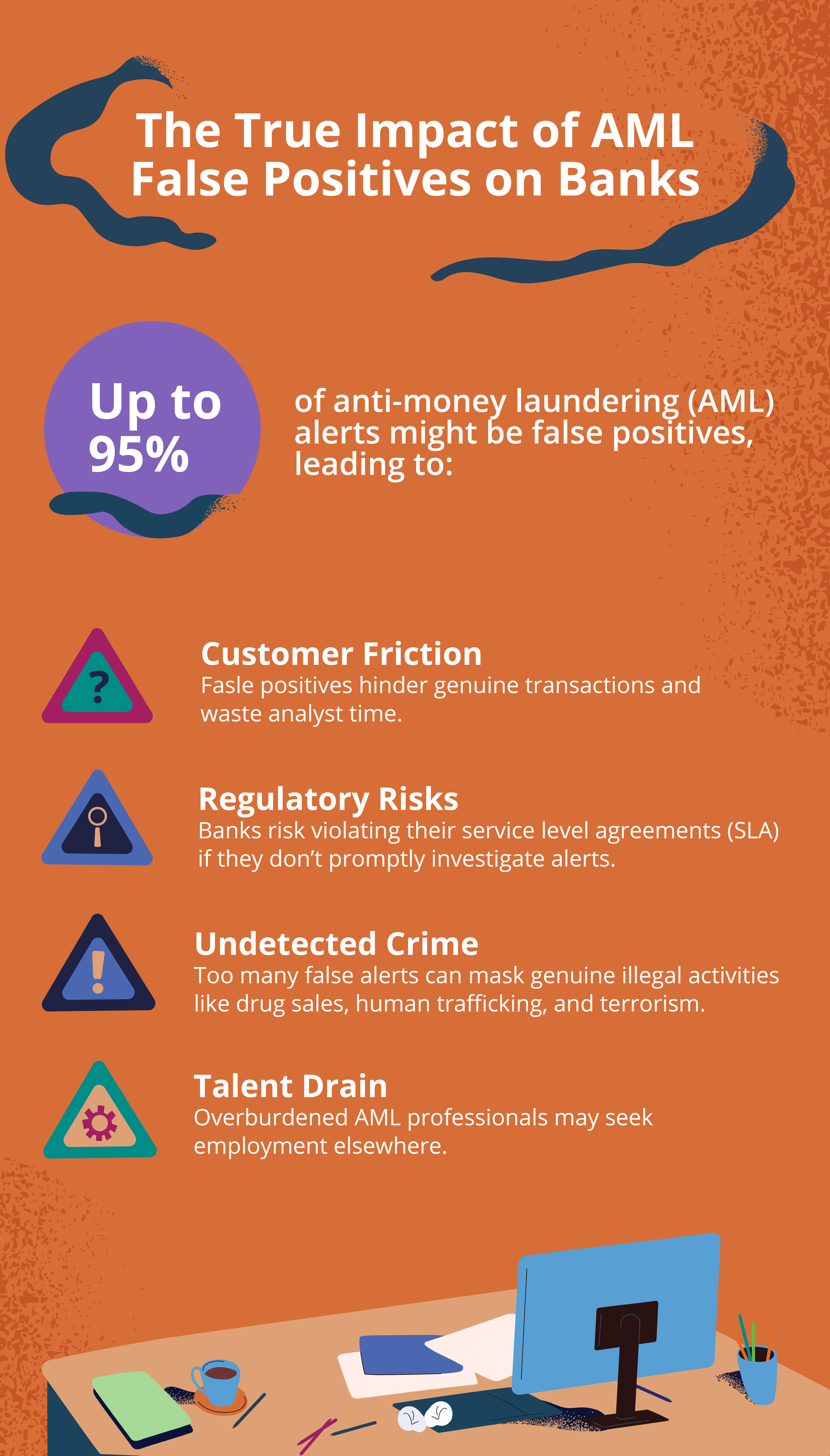
High false positive rates are considered the norm for many financial institutions. But they can also contribute to compliance professionals’ burnout from anti-money laundering (AML) transaction monitoring false positives. This is because many FIs’ AML compliance programs rely solely on rules-based monitoring instead of optimizing results using machine learning.
Unfortunately, the staggering level of AML false positive burnout can contribute to a talent gap in the industry. Financial institutions should find ways to improve their workflows, even though there may be many incorrect results. That’s where advanced technology can be a differentiator.
Here’s how banks can help compliance teams avoid AML false positive burnout.
What are AML False Positives?
Anti-money laundering efforts produce false positives when they mistakenly mark a genuine customer’s transaction (or multiple transactions) as suspicious. However, upon closer inspection, nothing suspicious is found. This happens when the transaction(s) triggers one or more of the financial institution’s rules. As a result, the transaction is flagged as a potential money laundering activity.
Around 95% of system-generated alerts are considered false positives by some estimates. This large number of AML false positives in transaction monitoring is music to the ears of financial criminals and money launderers. The longer analysts chase false positives, the longer criminal activities can continue uninterrupted. Ultimately, financial institutions waste valuable resources pursuing non-AML risks.
3 Ways False Positives Contribute to AML Analyst Fatigue
The overwhelming volume of false positives weighs down review teams, contributing to AML analyst fatigue in three key ways:
- The Human Factor. Chasing false positives can feel like spinning relentlessly on a hamster wheel. Many analysts want to channel their inner crime-fighting detective by pursuing meaningful investigations and stopping financial criminals. If they find their job is simply a checklist task, they eventually feel bored and disparaged by the work. Many analysts will consider working at another company or leaving the role altogether if there are no clear career advancement opportunities.
- The Tech Factor. The state of an organization’s technology can also contribute to burnout. The results can be devastating if an FI’s system relies on hundreds of rules operating ineffectively. This arrangement creates a tall maintenance order that analysts, specialists, and managers must address. Giving analyst teams a system that requires constant maintenance and oversight is a frustrating experience that negatively impacts morale.
- The Repetition Factor. Analysts often also feel bogged down by the repetitive, manual tasks that are part of their responsibilities. These tasks include accessing relevant customer data for investigations. Performing these manual tasks over and over again can leave analysts feeling stressed.


The 4 Real Costs of AML False Positives
Banks risk severe repercussions if the factors contributing to high false positive rates and analyst burnout are left unchecked. Banks that do not address false positive burnout among their AML compliance teams take significant risks in four key areas:
- Operational Costs. False positives ultimately add friction to legitimate customers’ transitions and waste analysts’ time. These FIs risk damaging their operational margins if their false positive rate keeps rising. As the FI’s volume grows, so will its false positive rates and operational costs (as well as opportunity costs).
- Internal Audits. Large alert volumes take longer to investigate. FIs risk violating their service level agreements (SLAs) and disrupting their internal processes if they do not quickly investigate alerts. This could have regulatory consequences as regulators audit workflows to understand why the organization failed to follow its SLA.
- Criminals Go Undetected. Arguably, the most severe consequence of false positive overload and analyst burnout is that illicit activity goes undetected. Criminals keep making money from illegal activities like drugs, guns, trafficking, and terrorism. Meanwhile, analysts waste time on wrong leads.
- Compliance Talent Shortage. The banking industry is facing a significant talent shortage. Professionals’ increased workloads – often driven by false positives – can drive talent away. Some organizations are turning to AI and machine learning to uncover money laundering activities. These organizations may become top destinations for AML compliance talent by making their daily jobs more manageable.
3 Steps for Banks to Reduce AML False Positives in Transaction Monitoring
Reducing false positive rates mitigates AML team burnout. Here are three steps banks can take to keep team members engaged and improve operational efficiencies.
1. Implement Strong AML Training Programs
Analysts want to succeed at their jobs but will feel discouraged if they spend most of their time addressing AML transaction monitoring false positives. Banks can train AML analysts to better identify suspicious activity and its opposite, improving their effectiveness in preventing it. Training programs engage staff in AML trends, motivating them to try new tactics and prevent crime.
2. Cross-Train AML Compliance Professionals
Giving team members exposure to different functions and activities will keep teams engaged. Rotational programs are a great way to offer team members career advancement and skills development. This will help them view their original role better and understand how it affects other parts of the organization.
3. Upgrade Your Bank’s AML Technology
FIs need low-maintenance technology systems they can trust. Staff who aren’t worried about their transaction monitoring system breaking or spending most of their time maintaining rules are focused on investigations. Ask your FI’s service department about your team’s issues and how leadership can help. Research what other companies are using and how they like their systems. Finally, consider implementing machine learning solutions that automatically perform some repetitive, manual tasks that bog down AML teams. That solution should also be smart enough to help you decide when to alert (and when not).
AML compliance teams are committed to doing their jobs and stopping financial criminals. They should feel supported in their roles. FIs must help team members avoid burnout from false positive fatigue and keep their teams focused on productivity. Providing proper career development, opening rotation opportunities, and investing in the right technology are critical to impacting false positive burnout. Investing in advanced technology will be crucial in helping banks address the industry’s skills shortage and avoid losing hard-to-find talent to competitors.
Share this article:
Related Posts
0 Comments5 Minutes
Spotlight on Denmark: Fraud and Financial Crime Insights from ‘Den sorte svane’
The recent documentary mini-series "Den sorte svane" has sent shockwaves through Danish…
0 Comments9 Minutes
Enhancing AML Transparency with Smarter Data
Doesn’t it seem like new financial threats crop up in the blink of an eye? That’s why…
0 Comments10 Minutes
Enhancing Anti-money Laundering Systems Architecture
A speaker at a financial crime conference I recently attended summed up the problem with…

